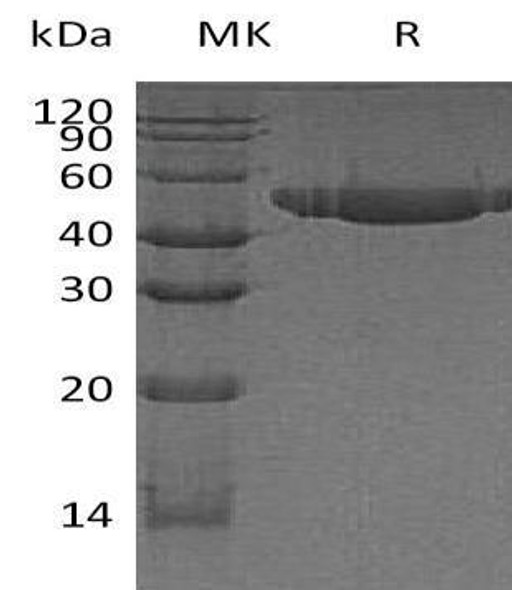Description
| Product Name: | Human NECTIN 2 Recombinant Protein (His tag) |
| Product Code: | RPES6076 |
| Size: | 20µg |
| Species: | Human |
| Expression Host: | HEK293 Cells |
| Synonyms: | Poliovirus Receptor-Related Protein 2, Herpes Virus Entry Mediator B, Herpesvirus Entry Mediator B, HveB, Nectin-2, CD112, PVRL2, HVEB, PRR2 |
| Mol Mass: | 39.49 kDa |
| AP Mol Mass: | 50 kDa |
| Tag: | C-His |
| Purity: | > 95 % as determined by reducing SDS-PAGE. |
| Endotoxin Level: | Please contact us for more information. |
| Bio Activity: | Testing in progress |
| Sequence: | Met1-Leu360 |
| Accession: | Q92692 |
| Storage: | Generally, lyophilized proteins are stable for up to 12 months when stored at -20 to -80°C. Reconstituted protein solution can be stored at 4-8°C for 2-7 days. Aliquots of reconstituted samples are stable at < -20°C for 3 months. |
| Shipping: | This product is provided as lyophilized powder which is shipped with ice packs. |
| Formulation: | Lyophilized from sterile PBS, pH 7.4. Normally 5 % - 8 % trehalose, mannitol and 0.01% Tween80 are added as protectants before lyophilization. Please refer to the specific buffer information in the printed manual. |
| Reconstitution: | Please refer to the printed manual for detailed information. |
| Background: | CD112 is a type I transmembrane glycoprotein belonging to the Immunoglobulin superfamily. It comprises one Ig-like V-type domain and two Ig-like C2-type domains in the extracellular region. The V domain is believed to mediate nectin binding to its ligands. Nectin2 is known to bind the pseudorabies virus, and herpes simplex virus2 (HSV2), involving in cell to cell spreading of these viruses. It does not bind poliovirus. As a homophilic adhesion molecule, CD112 is found concentrated in adherens junctions, and exists on neurons, endothelial cells,epithelial cells and fibroblasts. CD112 has been identified as the ligand for DNAM-1 (CD226), and the interaction of CD226/CD112 mediates cytotoxicity and cytokine secretion by T and NK cells. The costimulatory responses may be a critical component in allergic reactions and may therefore become targets for anti-allergic therapy. |






